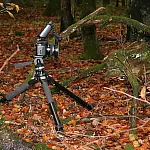Top Tips for Binocular Astronomy to See The Night SkyBinoculars play a big part in astronomy for beginners and experienced alike. These tips will help you make the most of Binocular Astronomy.
This article is part of a series of articles. Please use the links below to navigate between the articles.
- A Beginner's Guide To Observing The Night Sky - Stargazing!
- Tips for Improving Your Dark Eye Adaptation in Low Light Conditions
- Light Pollution and Dark Skies - Causes and Solutions
- How to Use Star Charts, Planispheres and Star Hopping
- Top Tips for Binocular Astronomy to See The Night Sky
- The Ultimate Guide to Moon Watching and Observing the Moon
- Tips for Buying Your First Telescope - What Type? How Big?
- What to Expect From Your First Night With Your First Telescope
- Sky Orientation through a Telescope
- Polar Alignment of an Equatorial Telescope Mount
- Everything You Wanted To Know About Telescope Eyepieces
- Which Astronomy Filters To Use For Astrophotography and Observation
- How to Photograph Constellations and Starry Nights
Binoculars play a big part in astronomy for beginners and experienced amateurs alike. They are generally cheaper and much easier to use than telescopes and offer a broad range of what's on offer in the night sky.
In many ways it's one of the purest forms of astronomy - without fiddling around with optics, computerised GOTO mounts and polar alignments, you can just pick up a pair of binoculars and look. What you find is a sky rich in fuzzy nebulae, spiral galaxies, binary stars, planets and of course the craters on the moon. Binoculars are simple to use, yet the rewards they bring are glorious.
A quick browse through various astronomy shopping websites will quickly show a wide range of good quality telescopic equipment available to purchase. For the beginner setting out to explore the sky for the first time and faced with this daunting choice, perhaps the best option before taking the plunge is to start small, or better still, learn one's way around the sky with a pair of binoculars before moving onto a larger, more powerful instrument. Even if you do invest in a large aperture telescope, a pair of binoculars still comes in handy for low-magnification reconnaissance of deep sky targets before bringing the telescope to bear.
Portability is a big factor in binoculars' favour. It's easy to move to a dark unobstructed spot for a view of something low down with binoculars - a good deal less so with a large reflector! For trips away from home binoculars are ideal and can be carried as hand luggage.
Binocular Astronomy
The choice of binoculars for astronomy is fairly straightforward. Binoculars are described in terms of magnification and aperture. For example, 10x50 binoculars have a magnification of 10 times and the main lens (objective lens) has a diameter (aperture) of 50mm. The aperture determines the light-gathering ability of any optical instrument. A larger aperture means more light is captured.
With an aperture of 50mm, under ideal conditions, the faintest stars will be of magnitude +11.2 so a pair of 10x50's should be able to show you all 109 deep sky objects in the Messier Catalogue.
Keep it Steady
Some binoculars such as 8x40's or 10x50's are comparably lightweight and can be hand-held during observation for several minutes at a time. To get a steady comfortable view it's a good idea to prop elbows on a convenient wall or fence or observe from a garden recliner where your arms can be given a bit of extra support. For longer sessions, binoculars should ideally be mounted and one of the simplest methods is to attach them to a camera tripod. Most photographic stores will sell an adaptor and some higher-magnification binoculars may even come with an adaptor.
With a steady mount, you are more likely to see fainter stars and deep sky objects and resolve finer lunar detail than you would by the handheld route. By the time we get to the realm of larger binoculars like 15x80, weight considerations make tripod mounting essential.
Optics and Mechanics
Like telescopes, binoculars come in a variety of configurations, each of which uses prisms to fold the optical path into short tubes. The most common are Porro prisms in which the eyepieces will appear slightly offset behind the objective lens. Roof prism models have a more straight-through layout. Focusing is often done via a central knob and good binoculars will allow independent focusing for either eyepiece - essential for everybody with less than 20/20 vision.
With binoculars (and everything else) you get what you pay for. Top-end binoculars will have ED glass optics and high transmission coatings and some may even have image stabilisation built in, but these cost a pretty penny. You can also pick up a decent low-magnification pair for less than











